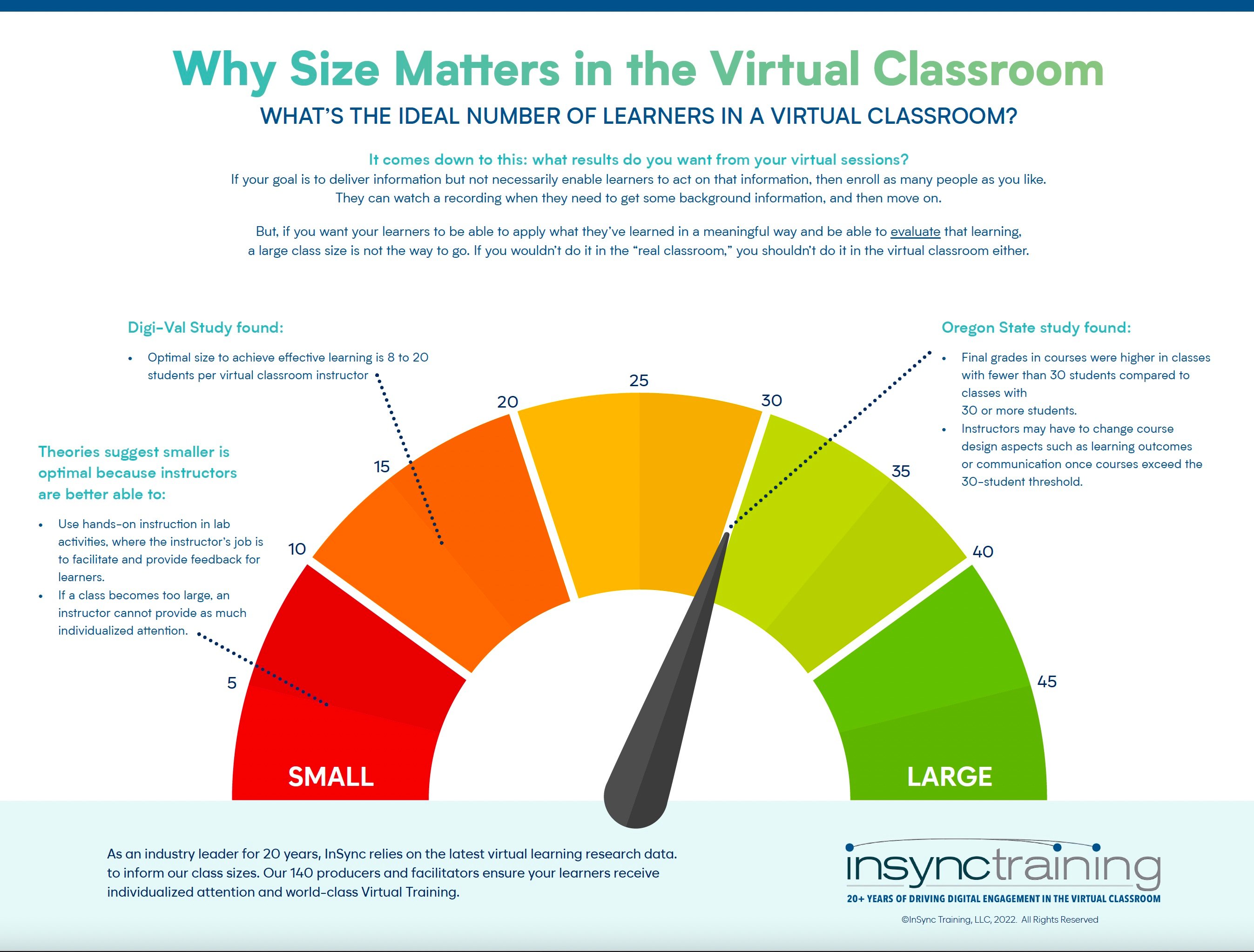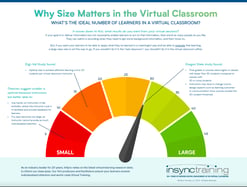How to Go Live! Moving a Great Course to the Virtual Classroom
5 Recommendations to Move Your Training Programs to the Virtual Classroom, and what Virtual Learning Experts™ Need to Know This is part of an ongoing...
2 min read
 Jennifer Hofmann
:
Jul 1, 2022 7:30:00 AM
Jennifer Hofmann
:
Jul 1, 2022 7:30:00 AM

As an industry leader for 20 years, InSync continually relies on the latest virtual learning research data to inform our class sizes. Our 140 producers and facilitators ensure your learners receive individualized attention and world-class Virtual Training. We provide an infographic, a little later in this post: Why Size Matters in the Virtual Classroom, with industry research surrounding virtual classroom size.
But - first, I asked members of our Facebook Virtual Classroom Community of Practice what they observe about class size in their hybrid virtual classrooms.

The question posed was - "Why should virtual classroom training sessions (real TRAINING) be kept to the same size as traditionally delivered classes. Any thoughts? Tips? Why or why not?"
Interestingly, we all agreed - bigger is NOT better in the virtual classroom and, if anything, hybrid class sizes should be even smaller than traditional classrooms in order to facilitate collaboration, interaction, breakout room activities and engagement.
Here are the top five reasons we came up with:
1. The larger the number of learners, the more the level of collaboration and interactivity decreases.
"A major point from my experiences is that the larger the number of participants, the level of interactivity and collaboration diminishes...i.e.: harder to do break out rooms or whiteboard when you have 30+...sure you can still do polls and chat...but level of engagement is different."
"It would be difficult for everyone to find a spot to write on whiteboard activities."
2. The larger the class size, the harder it is for the facilitator to give learners the attention they need.
"With many more participants, it would be hard for the virtual facilitator to give full attention to all participants in chat discussions."
3. The larger the number of participants, the more difficult it is to manage breakout room activities and learner success during those activities.
"It would also be challenging for the logistics of ensuring success in breakout room activities. Granted, you could have more producers or “helpers” to manage this, but it would be optimal if they had the subject matter expertise."
4. It would be difficult to maintain engagement when so many participants mean you can't involve everyone in activities.
"Part of the engagement of a smaller number of participants (15-20) in both the VILT and the traditional classroom for participants is knowing that they may be called on. This aspect makes participants pay attention. It's more critical in VILT because if there are so many participants that the facilitator can't keep track of them all...they can become invisible and it will be tempting for participants to multi-task and check email."
"We found that as the size of the class increased the instructors ability to effectively monitor these breakout sessions was diminished. That being said I think that even lecture only class maximums should be the same as brick and mortar training. Why would we expect an instructor to be able to manage more students in a virtual environment (if it's real training)?"
So what is the ideal number of learners in a virtual classroom?
Start with 80% of maximum size you would teach face to face, and increase as you ensure the content and activities are engaging and effective. You can always add more! To see the numbers that support this, download the infographic : Why Size Matters in the Virtual Classroom.
As we've mentioned earlier, size does matter ... in the virtual classroom ... and more learners at one time, especially virtually, is not an effective way for those learners to actually learn. If we want our learners to be able to apply what they've learned in a meaningful way and be able to evaluate that learning, a large class size is not the way to go. If you wouldn't do it in the "real classroom," you shouldn't do it in the virtual classroom either.
Class size is just one element to consider when designing an effective virtual training strategy. Effective virtual training takes specialized design techniques, facilitation mastery, and strong production support. Somebody needs to be the expert in your organization -why not you?

5 Recommendations to Move Your Training Programs to the Virtual Classroom, and what Virtual Learning Experts™ Need to Know This is part of an ongoing...

The pandemic, among many of its impacts on the learning and development community, mandated a rapid shift to virtual live learning. The past year’s...